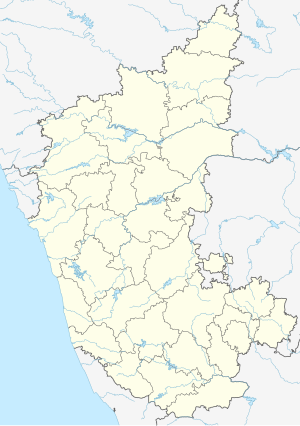| Bidar Fort | |||||||||||||||||||||||
|---|---|---|---|---|---|---|---|---|---|---|---|---|---|---|---|---|---|---|---|---|---|---|---|
| Old City, Bidar, Karnataka, India | |||||||||||||||||||||||
 Gumbaz Dharwaza, which acts as entrance into the fort | |||||||||||||||||||||||
| Coordinates | 17°55′28″N 77°31′36″E / 17.92444°N 77.52667°E[1] | ||||||||||||||||||||||
| Type | Fort | ||||||||||||||||||||||
| Height | 670 metres (2,200 ft) | ||||||||||||||||||||||
| Site information | |||||||||||||||||||||||
| Controlled by | Government of Karnataka | ||||||||||||||||||||||
| Open to the public | Yes | ||||||||||||||||||||||
| Condition | Ruins | ||||||||||||||||||||||
| Site history | |||||||||||||||||||||||
| Built | 15th century CE | ||||||||||||||||||||||
| Built by | Ahmad Shah I of the Bahamani dynasty from 1429 to 1432 | ||||||||||||||||||||||
| Materials | Laterite and lime mortar | ||||||||||||||||||||||
| Battles/wars | Siege of Bidar | ||||||||||||||||||||||
| Garrison information | |||||||||||||||||||||||
| Garrison | Bidar Garrison | ||||||||||||||||||||||
| |||||||||||||||||||||||
Bidar Fort is located in old city area, Bidar, Karnataka, India. The fort, the city and the district are all affixed with the name Bidar. Sultan Ahmad Shah I of the Bahmanid dynasty shifted his capital from Gulbarga to Bidar in 1427 and built his fort along with a number of Islamic monuments.[2][3] There are over 30 monuments inside Bidar fort.[4]
The complex was put by UNESCO on its "tentative list" to become a World Heritage Site in 2014, with others in the region, under the name Monuments and Forts of the Deccan Sultanate. The Bidar Fort has witnessed many historical milestones – the rise and fall of Bahmani dynasty, rise and separation of the five Deccan Sultans, capture by the Barid Shahi and Adil Shahi dynasties, and finally being won by the Mughal emperor Aurangzeb in the blockade of Bidar in 1657.
Bidar was the capital of Bahmani Kingdom in the 14th century. This fort was built by Ahmed Shah Wali Bahmani. The Fort was renovated in the 15th century by Sultan Ahmad Shah-I as he shifted his capital from Kalaburagi (Gulbarga) to Bidar.[5]
- ^ "Bidar fort". Wikimapia. Retrieved 17 April 2015.
- ^ "Heritage areas : Bidar-Gulbarga". kannadasiri.kar.nic.in. National Informatics Centre. Retrieved 12 April 2015.
- ^ "Bidar City Municipal Council". Cultural. Government of India (ASI). Archived from the original on 28 August 2009.
- ^ Desai, R. B.; Rozindar, Firoz & Patil, Vijayakumar (18 January 2015). "Not many follow the compass pointing north". The Hindu. Kasturi & Sons Ltd. Retrieved 17 April 2015.
- ^ Datta, Rangan (6 June 2023). "Bidar Fort in Karnataka: A treasure trove of south Indian heritage". The Telegraph. My Kolkata. Retrieved 11 October 2023.



